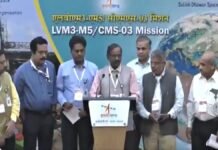
New Delhi: The Indian Space Research Organisation (ISRO) is all set to launch its latest meteorological satellite, INSAT-3DS, today i.e. on Saturday, February 17, from the Satish Dhawan Space Centre (SDSC) in Sriharikota, Andhra Pradesh. The satellite will be launched at 5.30 pm using the Geosynchronous Satellite Launch Vehicle (GSLV) Mk II rocket and will be placed in the Geosynchronous Transfer Orbit (GTO) approximately 20 minutes after lift-off.
INSAT-3DS is a collaborative effort between ISRO and the India Meteorological Department (IMD) and is part of a series of climate observatory satellites aimed at enhancing weather and climate services in the country. It is the seventh and final satellite of the INSAT-3D series, which began with the launch of INSAT-3D in 2013. The previous satellite of this series, INSAT-3DR, was launched in 2016 and is still operational.
The imager and sounder payloads will provide high-resolution images and atmospheric soundings of the Earth, which will help in monitoring and forecasting weather phenomena such as clouds, fog, rain, snow, fire, smoke, land and sea surface temperatures, humidity, wind speed and direction, etc. The data relay transponder will relay meteorological, hydrological and oceanographic data from remote and unmanned stations to the user agencies. The search and rescue transponder will assist in locating and rescuing distressed people on land, sea and air.
INSAT-3DS will also provide services to various departments under the Ministry of Earth Sciences, such as the National Institute of Ocean Technology (NIOT), the Indian National Centre for Ocean Information Services (INCOIS) and the National Centre for Medium-Range Weather Forecasting (NCMRWF). The satellite will augment the existing network of INSAT-3D and INSAT-3DR satellites and improve the coverage and accuracy of weather and climate information in the country.
This is ISRO’s second mission in 2024 after the successful launch of the PSLV-C58/EXPOSAT mission on January 1, 2024, which carried a scientific satellite to study X-ray polarisation from cosmic sources. This will also be the first time that the extended version of the cryogenic upper stage of the GSLV rocket, CUS-15, will be flown with an environment-friendly white fairing³. The white fairing is expected to reduce the thermal stress on the satellite during the launch.

ISRO has invited the public to witness the launch of INSAT-3DS from the newly built viewers’ gallery at SDSC, which can accommodate up to 10,000 people. The launch will also be telecast live on ISRO’s website and social media platforms.
















































